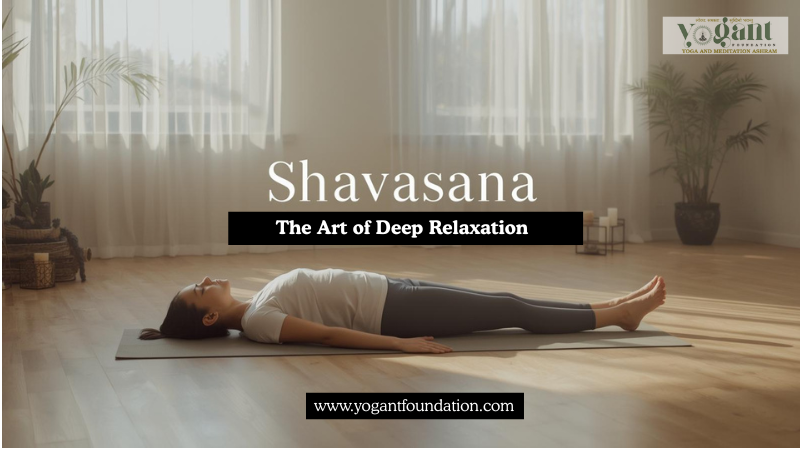Introduction: The Art of Complete Stillness
It may appear that the final posture, Meaning of Shavasana is simple following a yoga class with deep breathing and stretching. One of the most transformational and profound yoga asanas.
The Sanskrit word Shavasana is derived from Shava, which means “corpse”, and Asana, meaning “pose”. This pose is a perfect example of what its name implies. It invites the practitioner to lie still, completely motionless and without any tension. Although it may look easy, to achieve true relaxation when performing Shavasana, you must be aware, present, and willing.
This blog will explore everything that you need to learn about Shavasana, including its benefits, its steps, its techniques, its common mistakes, its variations, and its role as a meditation tool and healing technique.
What is Shavasana?
Most yoga practitioners perform Shavasana, or Restorative Yoga Posture, at the conclusion of their sessions. This allows the body to integrate and absorb the benefits of the previous asanas. It also calms the nervous system and integrates the energy created by movement and breathing.
This posture is a flat back position with the arms and legs spread out comfortably, closed eyes, and your entire body relaxed. Shavasana, despite its calmness, is a conscious state of relaxation. It’s a transitional moment between awakeness and sleep.
This is one of the best yoga postures because it revitalizes the body, mind, and soul.
The Spiritual Meaning of Shavasana
The yogic practice of Shavasana symbolizes surrender, the art to let go. We release control of ourselves and our ego in this pose. In this position, we merge with universal awareness.
It reminds us of our transience and that we need to rest and meditate. Shavasana is a pose that symbolizes the “death” of the self. It leads to inner peace and spiritual awareness.
Shavasana allows the practitioner to reconnect with their inner essence and transcend beyond the body.
How to Practice Shavasana (Step-by-Step Guide)
It’s essential to use the correct breathing and alignment techniques in order to enjoy the deepest experience of Shavasana fully. This is a step-by-step, detailed guide.
1 Step: Preparation
- Select a quiet, comfortable space with minimal distractions.
- A yoga mat or a quilt can be used to protect your spine.
- Lie on your back, legs straightened and slightly separated.
2 Step: Positioning the Body
- Let your palms face upward.
- As you relax your shoulders, make sure they are evenly distributed on the mat.
- Allow your neck to be in a neutral position and your head to rest.
3 Step: Breathe Naturally
- Take a few slow and deep breaths.
- Feel your body sink deeper with every exhalation.
- Let your breathing become effortless and soft.
4 Step: Relax Each Part of the Body
Relax every muscle as you move up, starting at your feet.
- The toes and the feet
- Legs and thighs
- Lower back and abdomen
- The chest and shoulders
- Hands and arms
- Neck, scalp, and face
5 Step: Stay Still and Aware
Stay motionless and aware of your breath. Rest in calm alertness and avoid falling asleep.
6 Step: Regaining Awareness
Continue to deepen your breathing after 5-10 minutes. Stretch your toes and fingers, then slowly move to the right before you sit up.
8 Amazing Shavasana Benefits for Health
Use Shavasana to improve your emotional, mental, and physical health. These are just a few of the many benefits this pose can provide:

1. Physical Relaxation: Shavasana releases muscle tension that has built up during daily yoga activities or other exercises. This pose improves circulation and energy.
2. Reduces Stress and Anxiety: Shavasana calms down the nervous and adrenal system. It helps in reducing anxiety. This pose helps to induce inner peace, deep relaxation and calm.
3. Enhances Concentration and Memory: Relaxed minds function better. Shavasana is a powerful tool that improves concentration, clarity, and memory.
4. Improves Sleep Quality: Practice of Shavasana prior to bedtime is a great way to combat insomnia. It also improves sleep by calming the mind and relaxing it.
5. Balances the Nervous System: The parasympathetic system is activated (the “rest-and-digest” response), which balances your body’s energies and promotes healing.
6. Helps Control Blood Pressure: Corpse Pose helps to lower blood pressure by reducing stress.
7. Emotional healing: The pose encourages emotional awareness and stability by gently releasing suppressed feelings.
8. Spiritual Growth: Shavasana, through deep stillness and meditation, connects with your inner self.
Science Behind Shavasana
Shavasana’s physiological and mental benefits are supported by scientific research. It has been shown to:
- Reduces blood pressure and heart rate.
- Increases the alpha brain waves (associated with creativity and relaxation).
- Relieves muscular tension
- Increases in respiratory efficiency
- Promotes the homeostasis of hormonal function and balance.
Corpse Pose is a transitional state that helps your body move from a “fight-or-flight” to a “rest-and-repair”. This shift in mode is necessary for overall health.
Common Mistakes in Shavasana and How to Avoid Them
Although Corpse Pose appears effortless to many, they make mistakes that reduce the effectiveness of this pose.
1. Falling Asleep: Corpse Pose, however, is not about sleep, but relaxed conscious. Slow breathing and mindfulness will help you maintain awareness.
2. Tension in the Body: Be sure to relax your entire body. Your position should be adjusted if discomfort occurs in the lower back, neck or shoulder.
3. Overthinking: When the mind wanders, gently bring it back to your breath or sensations in your body. Bring your attention gently back to the breath and sensations of your body.
4. Improper Alignment: Maintain a straight spine and evenly relax your limbs. If needed, use a pillow or bolster under your knees.
5. Rushing Out of the Pose: You should not stand up quickly. Let your body absorb the full benefits of returning to sitting.
Modifications and Variations of Shavasana
Corpse Pose needs to be adjusted for body types with different conditions.
1. Supported Shavasana: To relieve back and neck tension, place a blanket or a cushion under your knees.
2. Shavasana Side-Lying: The ideal position for women who are pregnant is to lie with their legs bent and a pillow between their knees.
3. Reclined Bound Angle Shavasana (Supta Baddha Konasana): Put your soles together, and then let your knees fall outward. Add some comfort by supporting them with cushions or blocks.
4. Weighted Corpse Pose: Grounding your body, using light sandbags to support the legs or the abdomen, will help you relax.
Shavasana in Meditation Practice
Corpse Pose, while part of the physical practice of yoga, also acts as a portal to meditation. This pose allows the mind to be still and prepares it for states of mindfulness and awareness.
Most meditation practitioners begin their meditation with Shavasana.
- Calms down the nervous system and body.
- Physical restlessness is reduced.
- It creates an open-minded mentality.
The pose is a bridge between Asana (posture) and Dhyana (meditation). It represents the inner journey of yoga.
The Role of Corpse Pose in Modern Life
In today’s society, stress and burnout are constant. Shavasana, a powerful treatment that teaches rest and calmness, is an effective remedy.
You can still benefit from Corpse Pose even if you do not practice yoga.
- Reset your mind.
- Restore your energy.
- Increase productivity and improve mood.
This is a useful tool to promote mental health in the workplace, school, or even at home.
Incorporating Shavasana into Your Daily Routine
Corpse Pose doesn’t require a complete yoga session. How to incorporate it into your daily life
- Morning reset: Shavasana is advisable to start the day with. The calmness will be set by this.
- Take a midday break: Enjoy a lunch break. You’ll feel more energetic at the office.
- Wind down your evening: Before you sleep, spend 10-15 minutes relaxing.
It’s important to be consistent. The more you relax, the easier it will become.
Corpse Pose and Pranayama Connection
The calming effect of Shavasana is enhanced when combined with Pranayama (breathing exercises).
Before Shavasana, try slow breathing techniques such as Anulomvilom or Bhramari to calm your mind.
Let your breathing flow naturally during the pose. This rhythmic breathing anchors the awareness of your body and enhances relaxation.
Contraindications & Precautions
Corpse Pose can be a safe practice for the majority of people. However, there are a few things you should do to ensure your comfort.
- For pregnancy women: Instead of lying on your back, practice side-lying Shavasana.
- Back pain sufferers: Place support under your knees.
- Trouble breathing: Lean your head back gently to breathe better.
Try guided relaxation, music-assisted practice, or guided meditation if you feel uncomfortable or anxious when still.
Guided Corpse Pose Script (for Deep Relaxation)
You can try this short guided Corpse Pose:
Close your eyes. “Close your eyes.
Inhale deeply and slowly exhale.
You will feel your body melt into the ground.
Relax your toes, your legs, your abdomen…
As you feel the warmth spreading up, your chest, shoulders, and arms will soften.
You sink into the peace with each inhalation.
Rest your Mind & Relax.
There is a calmness in your stillness.
“Stay here a couple of minutes in total surrender.”
The guided relaxation helps the beginner to experience Shavasana’s depth.
Shavasana and Yogic Philosophy
According to yogic texts like the Hatha Yoga Pradipika or Gheranda Sahita, Corpse Pose calms and removes tiredness.
This practice is based on the concept of “Pratyahara”, or the withdrawal of senses, which is the fifth limb of Patanjali’s Ashtanga Yoga. This inward journey allows practitioners to experience spiritual insight and true rest.
Corpse Pose, then, is more than just relaxation. It’s a doorway into self-realization.
FAQs about Shavasana
1. What is the best time to practice Shavasana?
Corpse Pose can be done at any time- during breaks or just before going to sleep. It is best to integrate the benefits from your yoga practice afterward.
2. How long should I stay in Shavasana?
Increase the time from 10 to 20 minutes for a deeper meditation or relaxation. For a deeper meditation or relaxation, extend the time to 15-20 minutes.
3.Can beginners do Shavasana?
Absolutely. All levels, body types, and ages are welcome.
4. Is Shavasana the same as meditation?
No, meditation does not. Shavasana is physical relaxation. Meditation is mental calmness.
5. Can Shavasana help with anxiety or depression?
According to studies, it calms down the nervous systems and can help reduce anxiety, mild depression, as well stress.
Final Conclusion: The Power of Stillness
The Corpse Pose shows us that doing nothing is beautiful, even when done consciously. Take a moment to breathe in deeply, take a pause, then connect with yourself.
If you’re an expert or a newbie yogi alike, Shavasana needs to be in your daily life. This pose is much more than that. You can also use it to practice meditation and an inward journey.
Every day, take a few minutes to close your eyes and just be. You’ll find peace in the quiet stillness.



